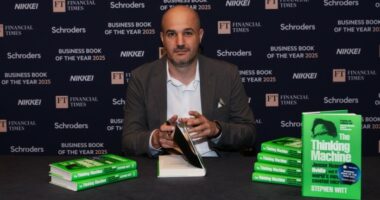Share this @internewscast.com
Opinions expressed by Entrepreneur contributors are their own.
Let’s begin with a challenging reality: most co-founders can slow you down, many investors seek control, and quite a few individuals start companies just to enhance their LinkedIn profiles, without fully believing in their concepts. That was never going to be me.
I made the deliberate decision to build my business alone. No co-founder, no “advisors” whispering suggestions, and no brainstorming sessions filled with endless opinions. I wasn’t seeking validation — I wanted speed and clarity.
People often question, “Isn’t it risky to venture out alone?” I understand that concern. But it’s riskier to entrust your vision to someone else and hope they uphold it with the same passion you do. I had a clear vision: a face recognition AI product ahead of the curve, a delivery platform that could evolve into a comprehensive ecosystem, and a wallet capable of scaling quietly without the typical startup fanfare.
I wasn’t going to pursue funding, wait for approval, or explain my vision to those who didn’t yet understand. I wasn’t interested in startup therapy sessions. I focused on achieving results and was prepared to work for them.
The hidden cost of “help”
A common misconception about solo founders is that they must handle everything independently — that being solo equates to being small and slow. This couldn’t be further from the truth. I didn’t build a team; I built systems that functioned like an efficient team.
Every wasted hour costs double when you’re alone, in terms of time and energy. I couldn’t afford the luxury of figuring things out later or relying on others. Everything needed to be lean, fast, and repeatable from the very beginning.
For example, I stopped taking endless meetings. Instead, I use Notion to track my decisions, next steps and ideas. It’s like a virtual COO who never forgets. Zapier automates my workflows, connecting apps, notifications and documents without my constant input. Canva and ChatGPT handle design and content without the overhead of a creative team.
Stripe and Google Workspace take care of invoicing, legal paperwork and onboarding — without a single assistant. Calendly manages scheduling, filtering meetings to only what truly matters.
Everything that could be systemized, automated or eliminated was. The goal wasn’t to do every task, but to make sure every task got done without slowing me down. Being solo means being sharp and disciplined, not stretched thin.
Focus only on what moves the needle
The mental game of building alone is often underestimated. It’s not about grinding nonstop or wearing every hat yourself. It’s about ruthless prioritization and protecting your mental energy for decisions only you can make.
I don’t spend hours on technical builds. I delegate development to offshore teams who specialize in what I need and follow the architecture I define. Design is templated and systemized. Admin work is automated or simply cut out.
My job is to think clearly, focus on the strategic and avoid the noise. That means locking in my daily plan the night before, setting a clear delegation process and applying a simple rule: if something takes more than an hour, I either systemize it or hand it off.
The pressure doesn’t come from doing it alone. It comes from trying to be everywhere at once. My edge isn’t that I do everything — it’s that I know exactly what only I can do and make sure everything else moves without me.
Proof comes from action not hype
I didn’t wait for launch day or perfect pitches to validate my ideas. I built quietly in the background and tested where it truly counts — the market.
One early success was a hardware AI concept I developed out of personal passion, not investor pressure. I made a lightweight, plug-and-play face recognition demo, then shared it privately with a few key people who influence adoption and trends.
The result? One buyer signed immediately under an NDA, two more asked for pricing without a formal pitch and the feedback was practical and deep, not surface-level praise.
No press releases, no ad spend, no waiting lists. Just product, context and real customer signals. That was proof enough.
Why I’d still choose to build alone
That early deal wasn’t a one-off. After delivering the proof of concept, I fulfilled the entire solution — negotiating terms, securing deposits and managing production — all without partners or funding. I kept control over every decision and every dollar.
Many assume co-founders or VCs are necessary milestones. I proved they’re not. When you build with clarity, protect your IP and execute with discipline, you don’t need more voices in the room. You need more control.
Building alone gave me confidence, clarity and capital. It let me walk away from one project so I could double down on bigger ones. It’s not about isolation — it’s about focused leverage.
Building a business alone isn’t about a lack of support. It’s about building on your terms. You don’t need to go viral or raise millions to succeed. You need to go all in — with focus, integrity and systems that work while you sleep.
If you’re debating the solo route, remember this: clarity beats consensus. Speed beats committee. Vision beats noise.
Build your way and build it strong.
Ready to break through your revenue ceiling? Join us at Level Up, a conference for ambitious business leaders to unlock new growth opportunities.
Let’s start with the hard truth: most co-founders slow you down, most investors want control and a lot of people build companies just because it looks good on LinkedIn, not because they truly believe in their idea. That was never going to be me.
I chose to build my business solo, intentionally. No co-founder, no “advisors” whispering in my ear, no brainstorming sessions dragging on with endless opinions. I didn’t want validation — I wanted speed and clarity.
People often ask, “Isn’t it risky to go it alone?” And I get that. But what’s riskier is handing over your vision to someone else and hoping they protect it with the same fire you have. I had a clear idea of what I wanted to build: a face recognition AI product before the market even caught on, a delivery platform that could grow into a full ecosystem and a wallet that could quietly scale without the usual startup noise.
The rest of this article is locked.
Join Entrepreneur+ today for access.










